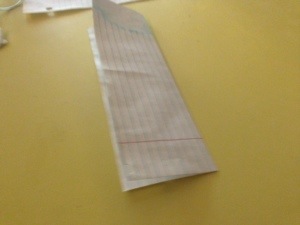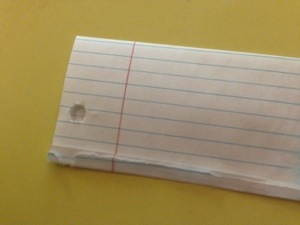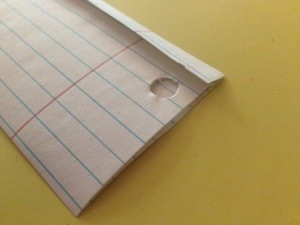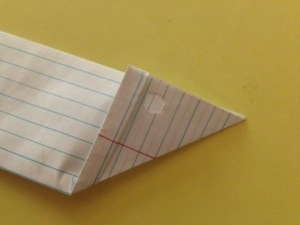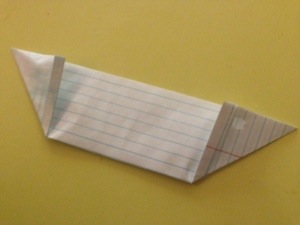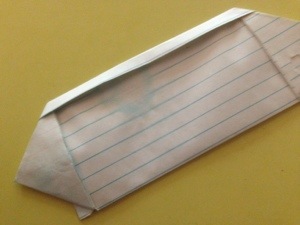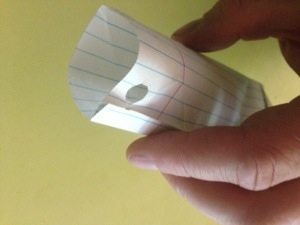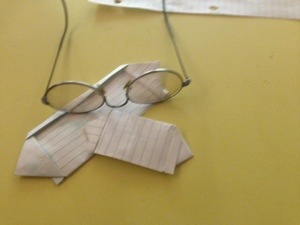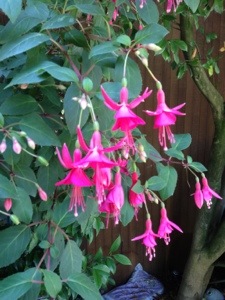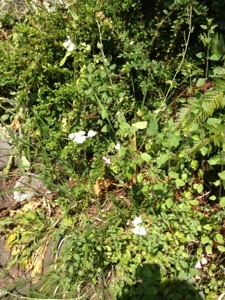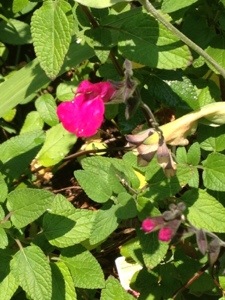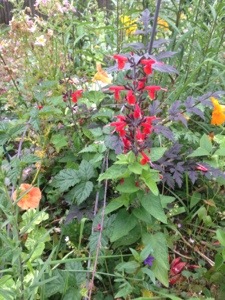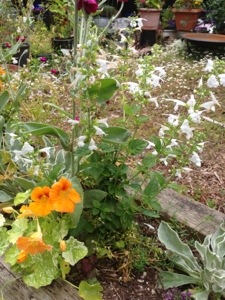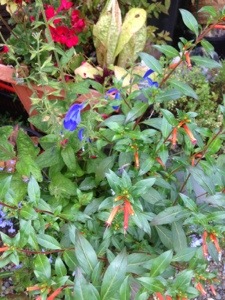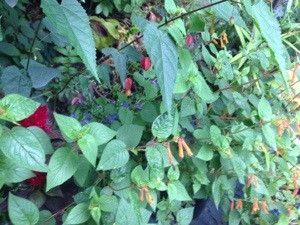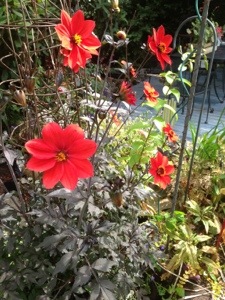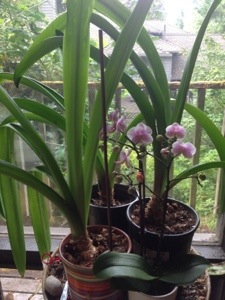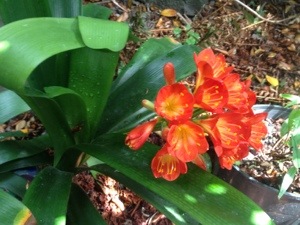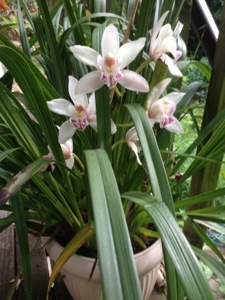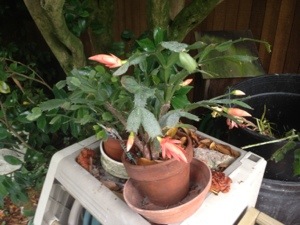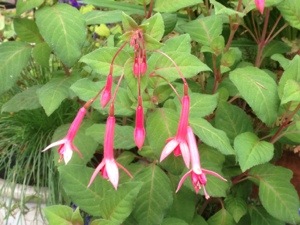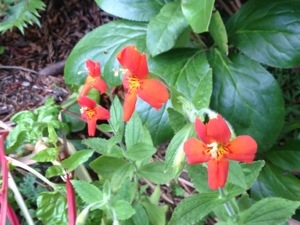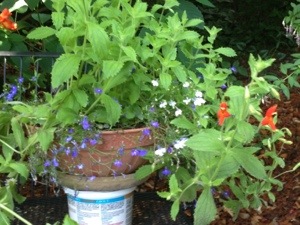There is a bunch going on in the garden this year, so I thought I would go through and make some notes on what is working and what’s not, to attract the hummingbirds.
So this morning I got up way too early, and went out to sit in the morning sun a d see if the hummers would show me what they like. I thought sitting in the truck would be good, cause it was still just a. It chilly in the shade, and that way the birds couldn’t see me. Unfortunately, with the sun on the window I could t see much either. But I did catch one visiting the scarlet runner beans, Phaseolus coccineus-
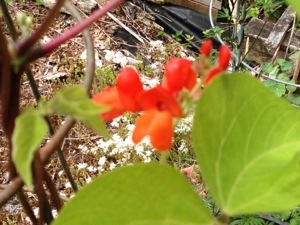
S/he must have liked it, since several flowers were visited before flying off.
Yesterday I was pleasantly surprised to see a juvenile visiting the flowers of the Japanese false indigo.
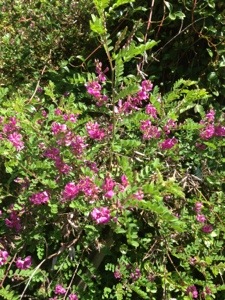
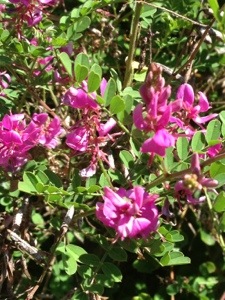
I’ve been calling this Lespedeza thunbergii in my What’s Blooming lists, since that’s what I remember it as, but looking at the pics online the leaves look different for that species, three part rather than 15-19 on mine. The flowers are very very similar though, and beloved of bees. I got this years ago from Heronswood, planted it in a pot and though it gets occassional splashes of water, it’s pretty much on its own. It’s thrived over the years, blooms heavily most of mid summer. This was the first time I’d seen hummers visit the flowers, but the little guy worked several flower spikes over in quick succession, so he must have gotten something he liked.
A plant I just got this year, though I have grown it in the past, is Mimulus cardinalis-
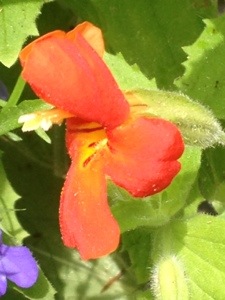
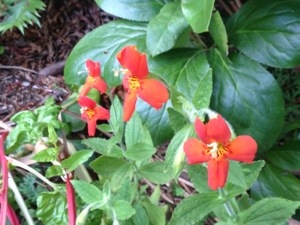
This rather sprawling California native is one of their favorites at the moment. It makes me want to install a stream or marshy pond in sun somewhere to give it the kind of garden space it would really thrive in. I love the bright reddish orange flowers, and the nice nectar lines in the throat. So do the hummers, consistently visiting these in their passes through the garden.
Another hands down favorite is the Salvia microphylla ‘Hotlips’
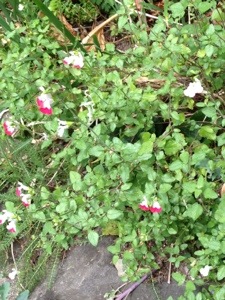
I love this salvia almost as much as the hummers. The cute little flowers often open in pairs, and the coolest thing is they change color based on the weather. When it’s cooler, they are all red. As it warms up, they to through bicolor stages, then when it gets really hot, they can be all white. With our variable temps around here, this time of year you can have all three present at one time.
Another Salvia they have enjoyed since I brought it home is Salvia x leucantha ‘Phyllis Fancy’-

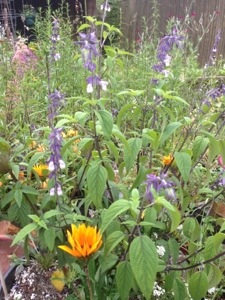
The fuzzy lavender stems and near white lavender flowers are very different from most of the garden. But I bought it in bloom this spring, and better than any other salvia in my collection, this one has bloomed and bloomed, and steadily increased in size. I need to fertilize I think, it’s now starting to look just a little run down. Something broke off a branch the other day too, and I need to make sure I take cuttings from that branch today. This is one I want to keep.
Another that has done well for me, though the hummers seemed to like it better a month ago than now, is Salvia ‘Wendy’s Wish’-
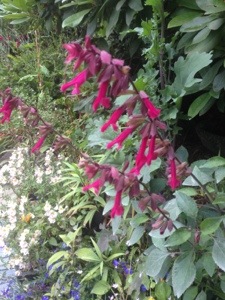
This one isn’t hardy here at all, so I am trying to decide if I want to bring one of the two in to overwinter, or trust that Langley Fine Gardens will have them again next year. I do love the color, and earlier it was one of the hummers faves, especially the one in the corner by the birdbath. It was fairly common to see them go from the fuchsias in the rockery, to the Salvia ‘Hotlips’, then to this one.
The other Salvia I have that has always been a steady repeat for me is Salvia coccinea ‘Forest Fire’-
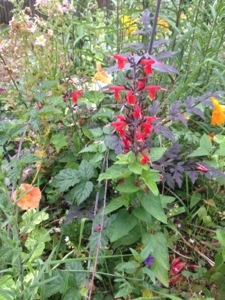
This picture is of one of the seedlings I took out of the bigger pot where one overwintered with the Begonia boliviensis and the lemon verbena. I also bought the white ‘Snow Nymph’ variety, which has attracted some hummer interest, but in general has been rather disappointing for me. It’s a little too dwarf and compact for my liking, and honestly the hummers don’t go out of their way for it.
The Begonia boliviensis ‘Bonfire’ is another that ill keep growing it till I kill it, mostly cause I like the flowers. I have seen hummers regularly use the one hanging through the railing off the back deck, but I suspect that is as much because the Salvia ‘Forest Fire’ is mixed with it, and they also like the fuchsias back there.
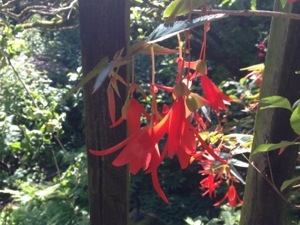
Speaking of Fuchsias, lol… I have more of those than any other group of cultivars, except maybe red flowering currants. We currently have three hanging baskets in the back- ‘Auntie Jinks’
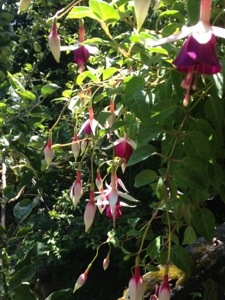
Which is nicely compact and seems to be the favorite of the three back here,
Marinka-
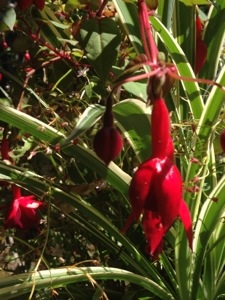
This is a. Odl fashioned cultivar I remember my dad growing, and is consistently a good one to attract hummers to hanging baskets, though these ones, overwintered from two years ago, are looking a little ragged. If I overwinter them again, I need to repot and fertilize more carefully.
The third hanging basket is ‘Princessita’-
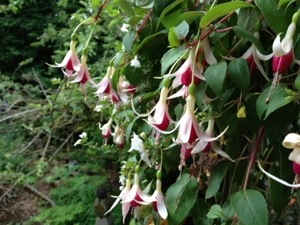
We got this one on sale, half off since it was wilted badly and some of the Bacopa growing in with it was dieing off. Water and a trim perked it right up, and it throws an amazing amount of flowers the hummers seem to like just fine.
Under these there is also a Fuchsia triphylla ‘Gartenmeister Bonstedt’, which we got at the Issaquah Farmer’s Market last fall.
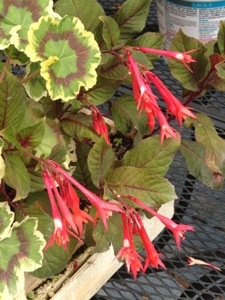
These are cuttings, taken from that plant late spring, blooming in my propagation unit. I really need to get them out of there, lol. We bought two at the market in fall, I planted on in a larger container to overwinter, and the other I hung from the fence and left out. It continued blooming till killed by heavy frost and freezing temps in December, long after I thought it would have curled its rather tropical leaves up and croaked. If I had known, I might have been able to bring that plant in and overwinter it too, getting it to regenerate in spring from the roots. As it is, the main plant has been in continuous bloom since we got it. It’s getting a little lanky and could use a trim, but is still flowering well. And attracting hummers.
Honestly in many ways I prefer the hardy fuchsias. One of these particularly so for sentimental reasons.

This is an heirloom variety of Fuchsia magelanica I got from my grandmother from her garden in West Seattle. Over there, and in the San Juans, this old variety (and quite possibly, seedlings of it, or maybe this is from a seedling of the originals), have been passed along gardener to gardener, over the back fence or, as my grandmother got hers, at church plant swaps and the like.its an untidy, but reliably hardy flu raining shrub. Takes a ton of abuse, drought tolerant within reason, likes sun but will take shade, just an easy going reliable performer. I remember my grandmother’s on the north side of the house, next to an enormous maiden hair fern, shaded by the house but otherwise pretty much in the open. For me it enjoys the bed behind a short fence, roots cool and protected but its branches mostly in the sun. It’s not the a site best Humplant in the garden, but it is certainly a reliable and steady attraction for them, over most of the summer and into fall.
An even more hardy one is the nearly white Fuchsia magellanica ‘molinae’-
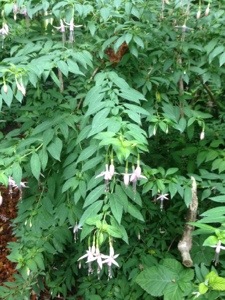
Until this year, this was almost always the first of my hardy ones to bloom, and has a much more upright, shrub over to almost small tree like habit. It grew to almost 15 feet before getting knocked back to the ground a few years back in one of those Arctic Freeze events we occassionally get, but has slowly recovered since, though it isn’t putting on the wood it did before. The palest pink and lavender bicolor flowers look soft white from a distance, and this is reliably on the favorites of the local hummers when it is in bloom, and it blooms for an incredibly long period, often starting in May and going through November when finally hit back by frost. I get the feeling if it was just a little warmer in winter, it would bloom year round.
A relatively new fuchsia for me, but that looks like it may be as hardy as molinae, is the hybrid ‘Whiteknight’s Amethyst’-
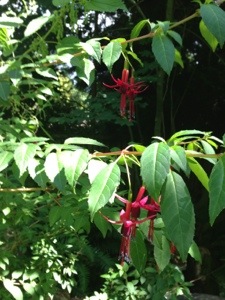
It a tuay started blooming slightly before molinae, and has a similar more upright form to it that makes me wonder if these are related. The flowers are the more typical scarlet red and deep purple of the species however. I love this plant, and if it proves to be as hardy as molinae, will be propagating it more to spread around the garden. maybe I should wat h for fruit and sew seeds…
Another species that has also done consistently well, both in terms of hardiness, and at attracting hummers, is the diminutive Fuchsia campos-portoi
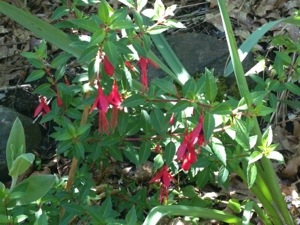
It wasn’t quite as early as the other two above, but close. It’s tiny leaves and compact, low shrub habit make it perfect for the rockery with the Salvia microphylla types. It sets fruit easily, so I’m tempted to let a few ripen and plant the seeds, to see what I get out of it. Although small, it produces lots of flowers the hummers seem to go for first, which is a great reason for growing more of it.
The final fuchsia worth mentioning for hummers is the standard I got last year, I’ve been referring to as ‘Display’. That’s a guess, since it didn’t come with a name on it, but it looks like that variety, which is apparently common around here for hanging baskets and the topiary like standards like this one. I carefully overwintered this inside since last summer it was THE favorite of the hummers on the front deck. Maybe because I have lots of other things for them, this year it hasn’t been quite so popular, it it does get regular visits. I’ve also propagated lots of it, overwinter a d this spring straight into pots. If it IS Display, it may even prove hardy here, which would be an added bonus. I like the flowers as much as the hummers, too. Though I dunno if the big standard is going to last long. The height is nice in the dark corner of the deck behind the tables, but it takes up a lot of indoor space over winter.
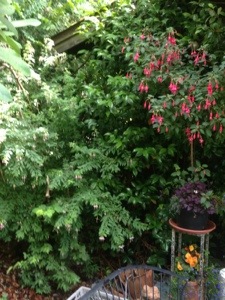
Another group I seem bent on collecting is the Cuphea genus. The hummer’s favorite of the group appears to be a dwarf form of Cuphea ignea-
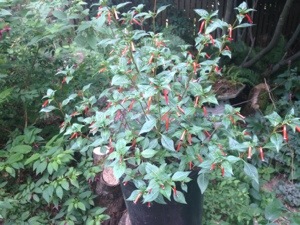
I have two of these, both in pots, both in shade since this particular one seems to prefer that, and hates drying out in the sun. I got this along with a bunch of other stuff from Langley Fine Gardens, the first time at the Arboretum sale where they are a regular vendor each year, and the second we went out to the West Seattle market, which they attend in spring. Some day I would love to visit them out on Vashon Island where their nursery is. Anyway, at the West Seattle market they also had a larger taller form-
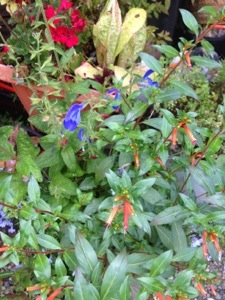
This one is growing with Salvia patens ‘Cobalt’, which so far I have yet to see a hummer visit, but it’s in a hard spot to discretely watch. Both of these Cuphea ignea cultivars seem excellent for attracting hummers though. I do wonder if this taller form is like the hybrid ‘David Verity’, or if its a natural selection of the species. It does grow much bigger, bigger flowers, and likes sun more than shade apparently. I like both though.
Another similar looking one is the Cuphea ‘Carribean Sunset’-

One online source said it is a selection or hybrid of C. cyanea. Whatever the. See, the smaller flowers are very pretty, and it does get some use, though it seems not quite as popular as the taller ignea in the rockery nearby.
Another plant near this that has for some attention is a red leaved, red flowered Dahlia cultivar-

I’ve had this in the garden for a couple of years now, but this year I transplanted it into a larger pot. I’ve never seen it used before, and it doesn’t seem to be a favorite, but the juveniles are using it sporadically so it is on this list for good reason. This may well be one of the Bishop series of tall, red leaved forms. It is certainly getting much bigger this year now that its got more root room. I think I will need to dig it up and divide it a bit this next winter or spring. The single flowers are bright and cheerful, so it is a welcome addition to the garden regardless.
One of the oddball subtropicals I got this spring is Justicia brandegeana-
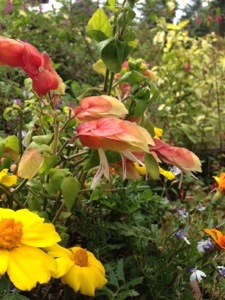
This odd little shrimp plant is probably wondering WTF in our cool weather, it seems to do better in the Gulf Coast states and down into Mexico. But it’s been in flower since I bought it and shows no signs of slowing down. Again, it seemed more popular earlier when there wasn’t as much blooming, but I do still see the occasional visit. Hardiness wise, this may be hardy here, but I am going to assume its not, and just need to figure out if it is going to be one of the ones I bring in or not. I like it, and wonder if it got bigger if it would prove more attractive to hummers? We will see I guess.
I have two native blooming that traditionally have been humflowers favorites; Fireweed (Chamerion angustifolium, formerly Epilobium angustifolium) and hedgemint (Stachys cooleyae). I haven’t seen either one used this year yet, but both are in out of the way corners where they are hard to watch.
Stachys cooleyae is a mint, spreads like a mint, and flowers for most of mid summer.
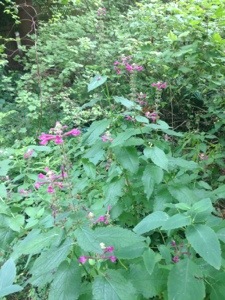
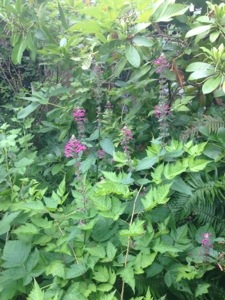 .
.
The bright pink candles on tall stems to four feet have always attracted hummers here. It likes rich soils that don’t dry out completely, even winter wet conditions, and prefers at least part shade unless you give it lots of water. It can tend to flop as the flowers get top heavy, so I like growing it with taller things that can help keep it upright, and not incidentally keep it from overcrowding everything around it.
Fireweed is not a mint, but spreads almost as aggressively. Where hedgemint likes shade, fireweed tolerates it but flowers best in full sun. Drought tolerant, but don’t let the roots sit out an dry out, it will simply shrivel and die. I have two forms, the native natural to the area pink-
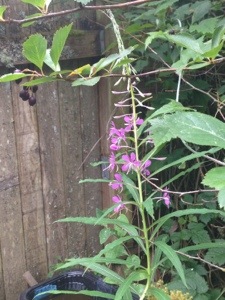
And a white variety that may be a European cultivar-
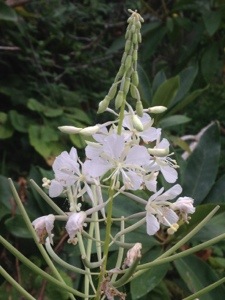
Both are lovely, and make beautiful garden flowers. I don’t find they spread so aggressively as to be a problem, but others may differ in their opinion. Funnily enough, this spring I knew we had dear in the garden not because I could see them, but because they had nipped each of the fireweed stems at around 8-10 inches. They are only just now starting to recover, lol. Hopefully next year I will have more to spread around for a nice grove of it in the back.
Along with the Salvias and Cupheas, I also got a few vines from Langleys. I got two different red morning glories. Ipomoea luteola has been blooming steadily through the roller coaster of warm to cool weather we’ve had.
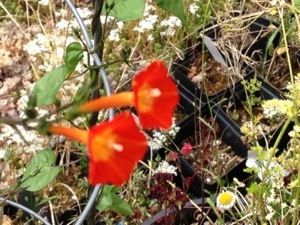
It’s not growing quite as strongly as its cousin I. multifida-

Both seem to get steady action from what flowers they have, though I get a distinct impression that they aren’t real happy here.
I have a bunch of other stuff that might be used by the hummers, things like Agastache, Schizanthus which was used earlier in summer, nasturtiums, etc, but these are the ones I regularly see visited this summer.

